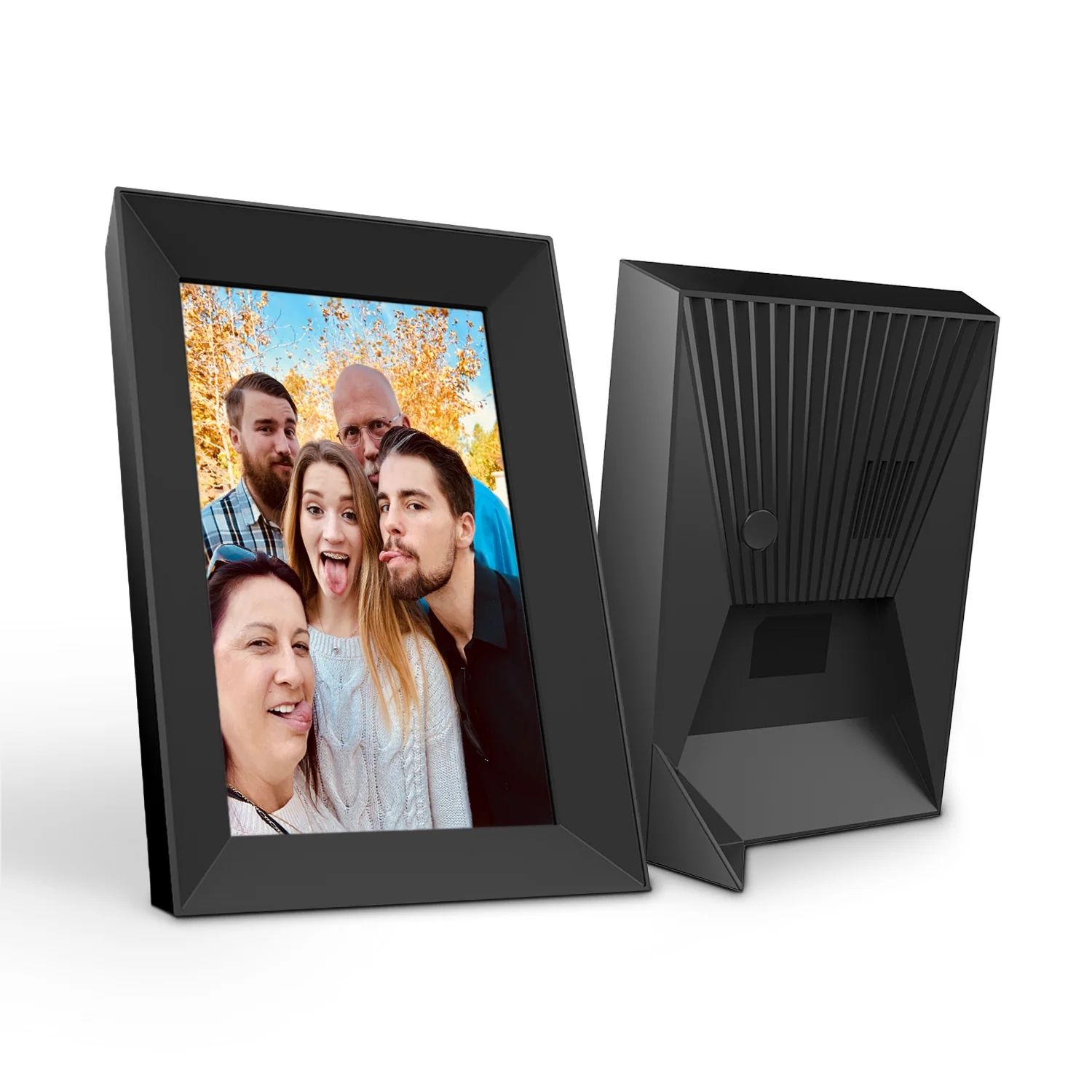Introduction
Welcome to the world of digital photo frames, where your favorite memories come to life in vibrant colors and high definition. These sleek devices are a modern twist on traditional picture frames, allowing you to display an array of images in a single frame. Whether you want to showcase photos from a recent vacation, highlight precious family moments, or simply add a touch of personalization to your living space, a digital photo frame is the perfect solution.
Gone are the days of flipping through photo albums or printing out multiple pictures for each frame. With a digital photo frame, you can effortlessly switch between different images, create captivating slideshows, and even customize the display settings to suit your preferences. These frames offer a seamless and convenient way to enjoy your favorite photographs without the hassle of manual labor.
In this guide, we will take you through the process of selecting the right digital photo frame for your needs, preparing your photos for optimal display, transferring the photos to the frame, arranging and organizing them, customizing the display settings, and troubleshooting common issues that may arise.
So, if you’re ready to bring your memories to life and adorn your home with a digital masterpiece, let’s dive in and explore the world of digital photo frames!
Choosing the Right Digital Photo Frame
When it comes to selecting the perfect digital photo frame, there are a few factors to consider. By understanding your needs and preferences, you can ensure that you find a frame that suits your requirements and enhances your photo viewing experience.
The first thing to consider is the size of the digital photo frame. Think about where you intend to place it in your home or office and choose a size that fits well in that space. Common sizes range from 7 inches to 15 inches, with larger frames offering more room to showcase your photos in all their glory.
Next, think about the resolution of the frame. Opt for a frame with a high-resolution display to ensure that your photos appear sharp, clear, and vibrant. Look for a frame with a resolution of at least 800×600 pixels or higher for optimal image quality.
Consider the connectivity options available on the digital photo frame. Most frames have USB ports and SD card slots, allowing you to easily transfer photos from your computer or camera. Some advanced frames even offer Wi-Fi connectivity, enabling you to stream photos directly from your smartphone or social media accounts.
Another important feature to consider is the frame’s aspect ratio. The aspect ratio determines the proportions of the screen and how your photos will be displayed. The most common aspect ratios are 16:9 and 4:3. Choose the one that best suits the composition of your photos and personal preferences.
Additionally, pay attention to the frame’s storage capacity. Some frames come with built-in memory, while others rely on external storage options like SD cards or USB drives. Determine how many photos you want to store on the frame and choose a capacity that accommodates your collection.
Lastly, consider any additional features that may enhance your photo viewing experience. Look for frames with adjustable brightness and viewing angles, intuitive navigation menus, and the ability to display videos and play music. These extra features can elevate your enjoyment and provide a more immersive experience.
By taking these factors into account and considering your personal preferences, you can choose a digital photo frame that meets your needs and allows you to showcase your cherished memories in the best possible way.
Preparing Your Photos
Before transferring your photos to a digital photo frame, it’s important to prepare them to ensure optimal display quality. Taking a few simple steps can make a noticeable difference in how your photos look on the frame.
The first step is to organize your photos and select the ones you want to display. This may involve going through your digital photo library and picking out your favorite shots or choosing photos that tell a story or capture a specific theme. By curating your collection, you can create a more meaningful and engaging slideshow.
Once you have selected your photos, it’s time to consider their resolution. The higher the resolution, the better the image quality on the digital frame. If your photos are too low in resolution, they may appear pixelated or blurry when displayed on the frame. Therefore, it’s advisable to use high-resolution images whenever possible.
In addition to resolution, it’s important to consider the aspect ratio of your photos. Most digital frames display photos in a landscape (horizontal) orientation, so it’s recommended to resize your photos to match this aspect ratio. This ensures that your images will fill the frame without any black bars or distortion.
Another consideration is the file format of your photos. Most digital frames support common image formats like JPEG, PNG, and BMP. It’s best to convert your photos to one of these formats, as they offer wide compatibility and ensure smooth playback on the frame.
Furthermore, you may want to enhance your photos by adjusting their brightness, contrast, and saturation levels. This can help bring out the details and make your images more captivating on the digital frame. Various photo editing software tools are available that allow you to make these adjustments easily and effectively.
Lastly, consider adding captions or titles to your photos if you want to provide context or add a personal touch. This can be done using photo editing software or even by creating a separate text file that accompanies your photos.
By following these preparation steps, you can ensure that your photos are ready to be transferred and displayed on your digital photo frame in the best possible quality. Taking the time to prepare your photos will enhance your viewing experience and allow you to relive your cherished memories with clarity and vibrancy.
Transferring Photos to the Digital Photo Frame
Once you have prepared your photos, it’s time to transfer them to your digital photo frame. Depending on the frame model, there are several methods you can use to accomplish this. Here are a few common ways to transfer your photos:
1. USB Connection: Most digital photo frames come with a USB port, allowing you to connect the frame to your computer. Simply plug in the USB cable, and your computer should recognize the frame as a removable storage device. Open the folder for the frame, and then copy and paste or drag and drop your prepared photos into the frame’s memory.
2. SD Card: If your digital photo frame has an SD card slot, you can transfer photos by inserting an SD card containing your prepared images. Make sure the SD card is formatted to a compatible file system (usually FAT32) before transferring the photos. Insert the SD card into the frame, and it should automatically detect and display the photos.
3. Wi-Fi or Cloud Storage: Advanced digital photo frames may offer Wi-Fi connectivity or integrated cloud storage options. These frames allow you to transfer photos wirelessly from your smartphone, computer, or cloud storage accounts. Follow the instructions provided with your frame to connect it to your Wi-Fi network or sync it with your preferred cloud storage service.
4. Bluetooth: Some digital photo frames support Bluetooth technology, enabling you to transfer photos from your smartphone or tablet. Pair your device with the frame using Bluetooth, select the photos you want to send, and initiate the transfer process. Check the frame’s user manual for specific instructions on how to connect via Bluetooth.
Regardless of the method you choose, it’s essential to follow the manufacturer’s instructions for transferring photos to ensure a smooth and successful transfer process. Once the photos are transferred, disconnect the frame from your computer or remove the SD card, and the frame should automatically start displaying the photos in a slideshow or allow you to manually browse through them.
Remember to keep a backup of your photos in case of any unforeseen issues or if you want to switch up the images on your digital photo frame. By regularly updating the photos, you can keep your frame fresh and showcase a variety of meaningful moments.
Enjoy the process of transferring your cherished memories to the digital photo frame and relish in the joy of seeing your photos come to life in a captivating and convenient display.
Arranging and Organizing Photos on the Digital Photo Frame
Now that you have transferred your photos to the digital photo frame, it’s time to arrange and organize them to create a visually appealing and cohesive display. Here are some tips to help you make the most out of your digital photo frame:
1. Slideshow Settings: Most digital photo frames offer options to customize the slideshow settings. You can typically adjust the display duration for each photo, the transition effects between slides, and the order in which the photos are shown. Experiment with different settings to find the one that best suits your preferences.
2. Folder and Album Creation: If your digital photo frame supports folder or album creation, take advantage of this feature to organize your photos. Create separate folders or albums based on themes, events, or individuals to make it easier to navigate through your collection.
3. Manual Sorting: If you prefer to have control over the order in which your photos are displayed, some frames allow manual sorting. This allows you to arrange the photos in a specific sequence by dragging and dropping them within the frame’s interface.
4. Randomize or Shuffle: To add an element of surprise and variety, consider enabling the randomize or shuffle option. This feature will randomly select and display photos from your collection, keeping your digital photo frame dynamic and refreshing to look at.
5. Rotation and Zoom: Some digital photo frames offer the ability to rotate or zoom in on photos. This can be useful for adjusting the orientation of vertical photos or highlighting specific details in landscape photos, enhancing the overall viewing experience.
6. Captions and Metadata: If your digital photo frame supports captions or displays metadata, you can add additional information to each photo. This can include dates, locations, or even short descriptions. The captions and metadata can provide context and enhance the storytelling aspect of your photo collection.
7. Background and Frame Options: Many digital photo frames allow you to customize the background or frame around your photos. You can choose from a selection of preloaded backgrounds or even upload your own images to personalize the frame’s appearance.
By organizing and arranging your photos thoughtfully, you can create a visually pleasing display that tells a story, evokes emotions, or simply brings a smile to your face every time you glance at your digital photo frame. Don’t be afraid to experiment with different settings and be creative in creating the perfect showcase for your cherished memories.
Customizing the Display Settings
One of the advantages of a digital photo frame is the ability to customize the display settings to suit your preferences. By adjusting various settings, you can enhance the visual appearance of your photos and create a personalized viewing experience. Here are some display settings to consider:
1. Brightness and Contrast: Most digital photo frames allow you to adjust the brightness and contrast levels. Experiment with these settings to find the optimal balance that makes your photos look vibrant and true to life without being overly saturated or washed out.
2. Aspect Ratio: Depending on the orientation of your photos and your personal preference, you can choose the aspect ratio that best suits your display. Some frames offer options for displaying photos in both landscape and portrait modes, ensuring that your photos always look their best.
3. Display Orientation: If you have a frame with a tilt or swivel function, you can adjust the display orientation to achieve the desired viewing angle. This feature is useful for frames that are placed on a tabletop or mounted on a wall.
4. Transition Effects: Add some visual interest and variety to your photo slideshow by selecting different transition effects. Options often include fades, wipes, slides, and zooms. Experiment with different effects to find the ones that enhance the overall viewing experience.
5. Date and Time Display: Some digital photo frames have the option to display the current date and time alongside your photos. This can be useful for keeping track of important dates or events and serves as a convenient reference.
6. Auto On/Off Timer: To conserve energy and ensure the frame is not constantly running, consider setting an auto on/off timer. This allows you to schedule specific times for the frame to turn on and off automatically, based on your preferred viewing hours.
7. Multiple Display Modes: Some frames offer different display modes, such as mosaic, collage, or split-screen. These modes allow you to display multiple photos simultaneously, creating a unique and visually engaging presentation.
8. Clock and Calendar: Take advantage of frames that offer additional features like a built-in clock or calendar display. This can provide a functional element to your digital photo frame, serving as a dual-purpose device.
Remember, the customization options available may vary depending on the model and brand of the digital photo frame. Refer to the user manual or consult the manufacturer’s website for specific instructions on adjusting the display settings on your frame.
By customizing the display settings according to your preferences, you can create a personalized and visually appealing showcase for your cherished photos. Take the time to explore and experiment with different settings to make your digital photo frame truly your own.
Troubleshooting Common Issues
While digital photo frames are generally user-friendly and reliable, you may encounter some common issues during their use. Here are a few troubleshooting tips to help you resolve any problems that may arise:
1. Display Issues: If the photos on your digital photo frame appear distorted, pixelated, or not displaying correctly, try adjusting the resolution settings of the photos. Ensure that they are in a compatible file format and that they meet the frame’s resolution requirements.
2. Frame Not Turning On: If your frame is not turning on, the first step is to check if it’s properly plugged into a power outlet. Ensure that the power cord is securely connected and that the outlet is functioning correctly. If the frame still doesn’t turn on, try resetting it by unplugging it for a few minutes and then plugging it back in.
3. Memory Card Issues: If your digital photo frame is not recognizing the photos on your memory card, ensure that the card is inserted correctly and that it is formatted to a compatible file system. Sometimes, using a different memory card or formatting the existing one can resolve the issue.
4. Slideshow Freezing or Skipping: If you experience issues with the slideshow freezing or skipping photos, make sure that the photos are not too large in file size. Large files can sometimes cause performance issues. Additionally, check if there are any corrupt or damaged photos on the frame and remove them to ensure a smoother slideshow experience.
5. Wi-Fi Connectivity Problems: If your digital photo frame has Wi-Fi capabilities and you are experiencing connectivity issues, ensure that the frame is within range of your wireless network. Check that the correct network credentials are entered correctly in the frame’s settings and that the Wi-Fi signal is strong and stable.
6. Touchscreen or Button Malfunctions: If the touchscreen or buttons on your frame are not responsive, check for any smudges or dirt on the screen or buttons. Clean them gently using a soft cloth. If the issue persists, try performing a factory reset on the frame to restore its default settings.
7. Firmware Updates: Occasionally, manufacturers release firmware updates that can address bugs, improve performance, and add new features to the digital photo frame. Check the manufacturer’s website for any available updates and follow their instructions for installing the latest firmware.
8. Display Connectivity Issues: If you are connecting your digital photo frame to a computer or other external device and experiencing connectivity issues, ensure that the cables are properly connected and functioning correctly. Try using different cables or ports to troubleshoot the issue.
If you have tried these troubleshooting tips and are still experiencing issues, refer to the user manual or contact the manufacturer’s customer support for further assistance. They will be able to provide specific troubleshooting steps based on the model and brand of your digital photo frame.
Remember, with a little patience and troubleshooting, most issues can be easily resolved, allowing you to continue enjoying your collection of precious memories on your digital photo frame.
Final Thoughts
Digital photo frames have revolutionized the way we display and enjoy our cherished memories. They provide a convenient and versatile way to showcase a collection of photos without the limitations of traditional frames. With the ability to display multiple images in a slideshow format, customize display settings, and easily update the photos, digital photo frames offer a unique and personalized viewing experience.
When choosing a digital photo frame, consider factors such as size, resolution, connectivity options, and additional features that enhance your photo viewing pleasure. Take the time to select the frame that best suits your needs and preferences, ensuring that your photos are displayed in their full glory.
Remember to prepare your photos before transferring them to the frame. Curate your collection, resize images to match the frame’s aspect ratio, and consider enhancing them with adjustments and captions to make them even more visually appealing and meaningful.
Transferring photos to the digital photo frame is a straightforward process, whether through USB, SD card, Wi-Fi, or Bluetooth. Follow the manufacturer’s instructions and explore the various methods available to find the one that works best for you.
Arranging and organizing your photos on the digital photo frame allows you to create a visually pleasing display that tells a story or showcases your favorite moments. Experiment with slideshow settings, create folders or albums, and consider adding captions or metadata to enhance the overall viewing experience.
Customizing display settings such as brightness, contrast, transition effects, and aspect ratios allows you to personalize your digital photo frame even further. Adjust these settings to suit your preferences and create a visually appealing showcase of your photos.
Finally, in case you encounter any issues, refer to troubleshooting tips or contact the manufacturer for assistance. Most issues can be resolved with a little troubleshooting or software updates, ensuring a seamless and enjoyable experience with your digital photo frame.
Embrace the world of digital photo frames and let your cherished memories come to life in a captivating and convenient display. With a little creativity, customization, and care, your digital photo frame will be a focal point of joy and nostalgia in your home or office.

























